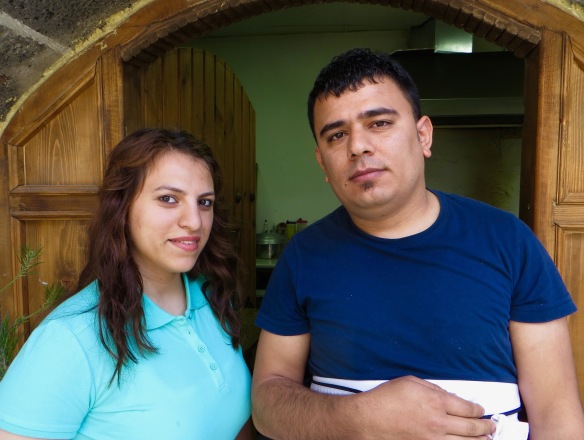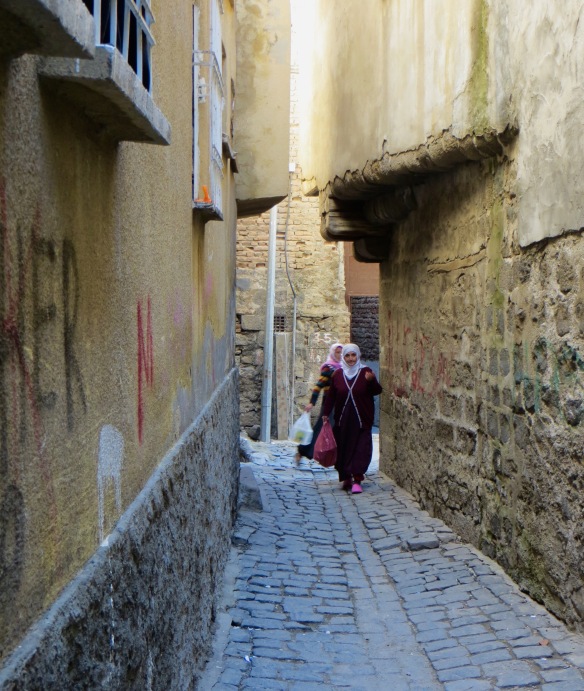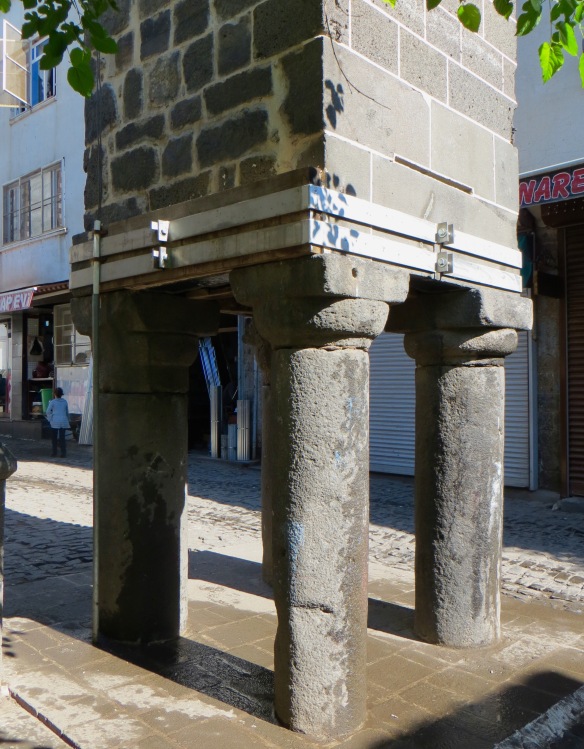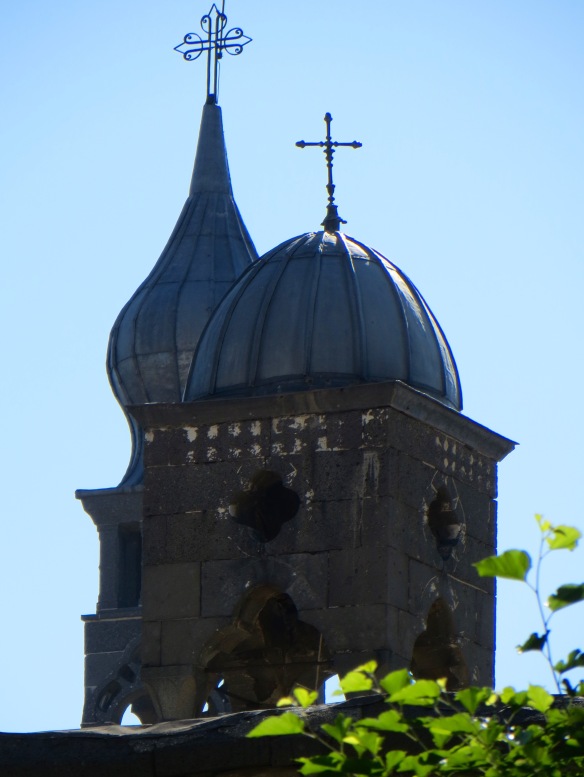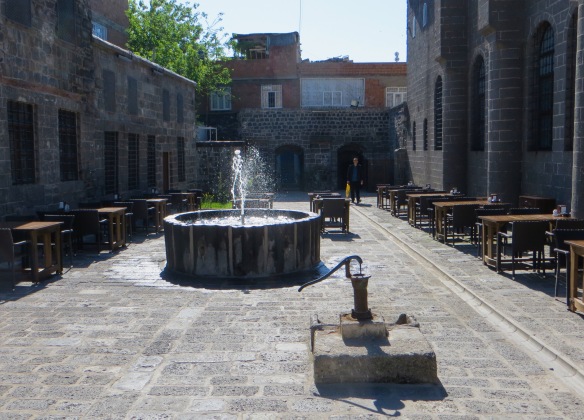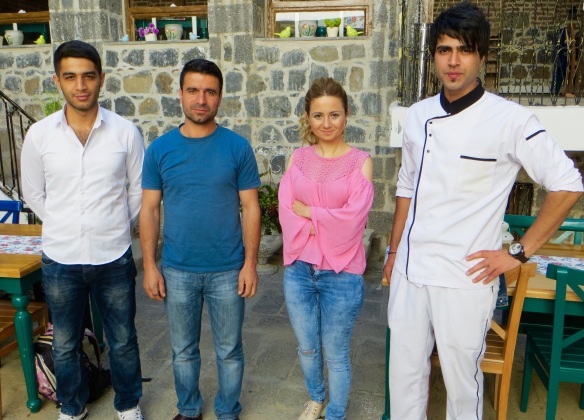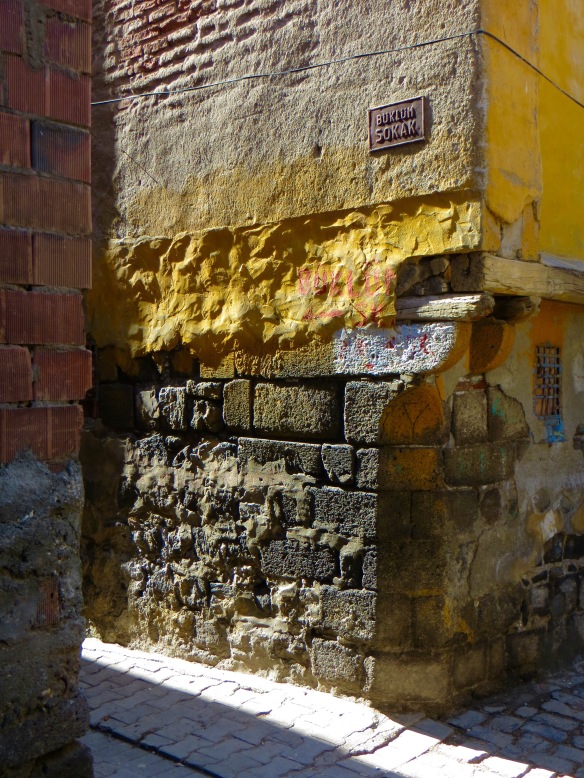There were two nearly new single beds in my room, an electric fire on one of the walls, a rail with a few hangers for clothes and a mirror with a frame painted gold. Two windows overlooked the street outside and another window the courtyard below. The walls were bare brick from which the plaster had been removed. A cheap rectangle of carpet imperfectly covered the floor. The door led to a small enclosed area with a sofa shared by the next bedroom along. I was in the room closest to the toilet, wash basin and shower, and there was hot water all the time. A double door led from the courtyard to the street outside, and stone steps led from the ground floor to the one above and from there to the flat roof.
The first thing I did after washing and dressing was to ascend the steps to the roof from where I could see the surrounding buildings, Surp Giragos Church and its restored bell tower included. Most of the surrounding buildings, whether old or new, were in a shabby state, but small patches of garden had survived and a few women engaged in chores on nearby roofs. The roofs were convenient places on which to hang washing lines to dry clothes. I was in Aslihan Antik Pansiyon, Café ve Restorant on Seftali Sokak and enjoying every moment of my visit.
By about 7.45am, a few people were in and around the courtyard getting things ready for the day ahead (in the mornings, most customers visited the Aslihan to enjoy a notably generous breakfast), but I was advised that breakfast would not be served until just before 9.00am. This did not worry me because my next destination was not far from Diyarbakir and, before moving on, I wanted to walk the short distance though the narrow streets to Surp Giragos Church. This I did, with a few short detours to remind me of this fascinating part of the old city (I passed the nearby Chaldean Church, Seyh Mutahhar Camii, Dortayakli Minare and some old but rundown houses, all of which were located along narrow cobbled streets where businesses were opening for what their owners hoped would be a busy Saturday). When I pointed my camera to take a few photos of the buildings, Sunni women averted their eyes or hid their faces with a headscarf, even if they were aged over 50, but men spoke a few words by way of extending a welcome.
The doors leading to the compound around Surp Giragos Church were open and, inside, two Armenians were preparing the café and lokanta to welcome lots of visitors later in the day. Some visitors would be Armenians from western Turkey or abroad, but there would also be many Islamicised Armenians and Muslims of Kurdish origin from in and around Diyarbakir, all of whom wanted to engage with the church and its grounds so attractively restored a few years earlier. Things looked very encouraging. The church had become a valued addition to Diyarbakir’s many tourist attractions, but, so far, had been subjected to vandalism no more serious than some fading graffiti on the wall enclosing the compound.
I returned to the pansiyon, was given a freshly fried borek to nibble before breakfast proper, chatted with some of the staff and quickly became aware that the driving force behind the business was a young Kurdish woman with hair dyed a fetching shade of red with a hint of blonde. I sat at a table in the shade and breakfast was brought on two wooden platters with a basket containing two types of bread. One platter had borek, fried potatoes in their skins, tomatoes, cucumber and different salad leaves, and the other had four types of cheese, three types of olive, more tomatoes and salad leaves, and no fewer than eleven small dishes containing butter, kaymak, pekmek, honey, hazelnut spread, a spread I could not identify (but it tasted very good) and five excellent jams. The food was so good that I needed three large glasses of tea to do it justice. Just as I was thanking staff for providing perhaps the best breakfast I have ever had in Turkey, two men walked into the pansiyon to order the same meal for themselves. My meal had been made all the more pleasurable because, instead of one or two members of staff joining me to ensure everything was okay, they prepared things for customers coming later in the day or devoted their spare time to their mobile phones.
I gathered up my belongings, thanked staff for making my stay so enjoyable and settled the bill, then walked through part of the increasingly lively pazar before entering the courtyard of Ulu Camii for old time’s sake. The exit was closed that led from the courtyard to the Ziya Gokalp Museum. The museum had been gutted by an arson attack in late 2014 when Kurds in the city found Turkish government inaction in relation to the Islamic State’s seizure of Kobani in Syrian Kurdistan inexplicable (Ziya Gokalp was a highly contentious figure among Turkey’s Kurds because, although Kurdish himself, he declared himself committed to Turkish nationalism). This meant I could not see what damage had been done without a detour. I called at an information office near Ulu Camii for a map of Diyarbakir, then walked to Urfa Kapi from where I caught a minibus to the garaj from where minibuses left for destinations north and north-west of Diyarbakir. I was spending the night in Cermik, the birthplace of Ziya Gokalp, because Cermik and the nearby town of Cungus have some important monuments I wanted to see for the first time. Within 15 minutes of arriving at the minibus garaj I was on my way, but the first half hour was spent trawling the suburbs of north-west and north Diyarbakir until almost all the seats were occupied. One place where we picked up passengers was outside the Ninovar Park shopping centre, which was in far better condition than Ninevah itself, so recently the subject of as-yet unquantified destruction by the Islamic State.

